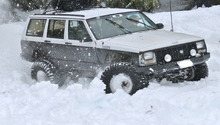Jeep Cherokee and Jeep Grand Cherokee 1984-2004: Tires General Information and Specs
Read on to learn how to properly size and maintain the tires on your Cherokee for optimum driving performance.
This article applies to the Jeep Cherokee and Jeep Grand Cherokee (1984-2004).
If your system's fluids are the lifeblood of your Jeep Grand Cherokee, then your tires are the muscles that allow it to move. A good set of tires will help you cross thousands of miles of road while stopping, slowing down and turning along the way. The tires do all that without experiencing unnecessary blowouts, drops in tire pressure due to high tire temperature, or decreases in gas mileage due to a myriad of road-related issues. Let's go over the general information you'll need to know before investing in a new set of tires, including what wheel specifications are right for your Cherokee.
Wheel Specifications
Before purchasing a new set of tires for your Jeep, you'll need to know your wheel size, which is based on very specific measurements. Using an online wheel and tire calculator, you can get the best fitment you need at the price you wish to spend. Most major tire manufacturers today offer their own websites where you can purchase new tires at competitive prices.
| Grand Cherokee | O.E.M. Wheel Size | Lug Pattern Metric | Lug Pattern Inches | Stud Size | Hub/Center Bore | Offset |
|---|---|---|---|---|---|---|
| 1993-1999 | 15 x 7 | 5 x 114.3 mm | 5 x 4.5 in. | 1/2-RH | 71.5 | M/H |
Tire Size and Wheels
For 10.5 inch tires, you'll want to stock to 16 x 8 inch wheels, though 16 x 7 inch wheels will also work. If you decide to go up to 12.5 inch tires, the 16 x 8 inch wheels will also work on those. Some Jeep owners noted minimum power loss with a seven inch wheel, but the loss should be only a minimum, if any. Keep your tires properly inflated and you should be fine either way.

Tires and Lifts
When dealing with a massive lift, say 6.5 inches, you'll want to find an appropriately sized lift kit to install, which you can install yourself or hire a professional mechanic to install them for you. It's recommended that you stick to a 33 inch tire for the cleanest fit possible. A 35 inch tire will also fill up the wheel nicely without leaving too much wasted space. If you won't be going off-roading at all, you might be able to sneak up to 38 inch tires; however, this could warrant a test on the road to see if the fit is good. Keep in mind, however, 33 inch tires will fit the best, offer the cheapest price tag, and give you the best gas mileage.

Figure 2. This is a 1999 Jeep Grand Cherokee with a 6.5-inch lift and 35-inch tires.

Figure 3. This is a 1999 Jeep Grand Cherokee with a 6.5-inch lift and 33-inch tires.
Scheduled Maintenance
Rotate your tires every 3,000 miles and check your tire pressure to make sure you're not at risk of a blowout. It's recommended that you keep a tire pressure gauge on hand to monitor your tires as the temperature rises or drops throughout the year. If you don't own one (they retail for about $10+), don't worry, you can also pop over to a local gas station and use the one there for free.
Common Questions
How long do most tires last?
For the most part, you can expect to get about six years of life out of a good set of road tires. Mud-terrain tires will vary depending on your driving style. However, you should be able to achieve approximately 40,000 miles of road and off-road driving.
Are tire warranties worth it?
Your decision to invest in a tire warranty, depending on the cost of the tire could be pretty expensive, will depend on a number of factors, including the expected mileage you hope to get out of the tires. Keep in mind each company has its own threshold for how claims are approved, so you'll need to be mindful of any limitations associated with the warranty.
Common Issues
Tire Blowout
A tire blowout can occur at any time, particularly when you have too much or too little tire pressure in your tires or the tread depth on your tires is worn down to 2/32 inches or less.
Tire Rub
If your tires are too big, you could experience a condition known as "tire rubbing" when you drive, which is more common when crossing an uneven road. Tire rubbing essentially means your tires are "rubbing" or coming into contact with parts of your vehicle while you drive. You have two main options here: reduce the size of your tires or install a tire lift kit, which can range in price from $500 to $1,500. Cheaper and more expensive lift kit varieties are also available, but this price range should offer some good choices.
It's important to note: 30 x 9.5 x 15 tires are about as big as you can go on stock Grand Cherokee wheels. (If you go any bigger, tire rubbing is extremely likely to happen, it will be almost imperative that you add a tire lift to reduce or eliminate the problem.) Goodyear, Wrangler DuraTech, and BFGoodrich will be your go to brands for high quality tires of this size.
Related Discussion
- Please Help What Size Tires Fit - CherokeeForum.com






